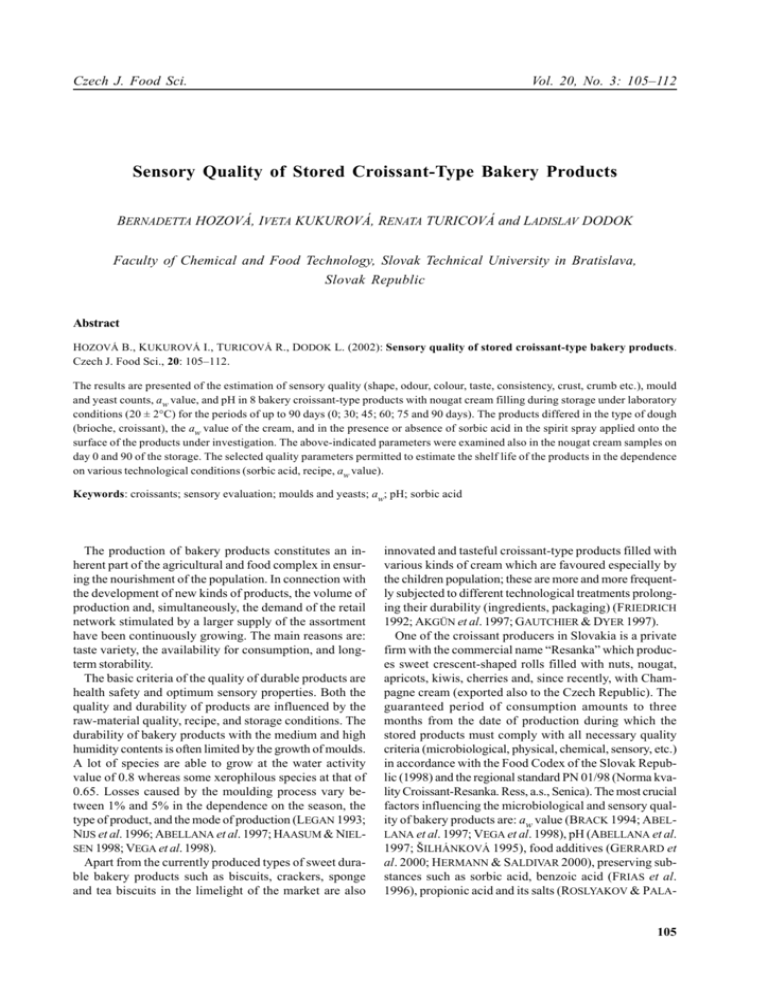Sensory Quality of Stored Croissant
advertisement

Czech J. Food Sci. Vol. 20, No. 3: 105–112 Sensory Quality of Stored Croissant-Type Bakery Products BERNADETTA HOZOVÁ, IVETA KUKUROVÁ, RENATA TURICOVÁ and LADISLAV DODOK Faculty of Chemical and Food Technology, Slovak Technical University in Bratislava, Slovak Republic Abstract HOZOVÁ B., KUKUROVÁ I., TURICOVÁ R., DODOK L. (2002): Sensory quality of stored croissant-type bakery products. Czech J. Food Sci., 20: 105–112. The results are presented of the estimation of sensory quality (shape, odour, colour, taste, consistency, crust, crumb etc.), mould and yeast counts, aw value, and pH in 8 bakery croissant-type products with nougat cream filling during storage under laboratory conditions (20 ± 2°C) for the periods of up to 90 days (0; 30; 45; 60; 75 and 90 days). The products differed in the type of dough (brioche, croissant), the aw value of the cream, and in the presence or absence of sorbic acid in the spirit spray applied onto the surface of the products under investigation. The above-indicated parameters were examined also in the nougat cream samples on day 0 and 90 of the storage. The selected quality parameters permitted to estimate the shelf life of the products in the dependence on various technological conditions (sorbic acid, recipe, aw value). Keywords: croissants; sensory evaluation; moulds and yeasts; aw; pH; sorbic acid The production of bakery products constitutes an inherent part of the agricultural and food complex in ensuring the nourishment of the population. In connection with the development of new kinds of products, the volume of production and, simultaneously, the demand of the retail network stimulated by a larger supply of the assortment have been continuously growing. The main reasons are: taste variety, the availability for consumption, and longterm storability. The basic criteria of the quality of durable products are health safety and optimum sensory properties. Both the quality and durability of products are influenced by the raw-material quality, recipe, and storage conditions. The durability of bakery products with the medium and high humidity contents is often limited by the growth of moulds. A lot of species are able to grow at the water activity value of 0.8 whereas some xerophilous species at that of 0.65. Losses caused by the moulding process vary between 1% and 5% in the dependence on the season, the type of product, and the mode of production (LEGAN 1993; NIJS et al. 1996; ABELLANA et al. 1997; HAASUM & NIELSEN 1998; VEGA et al. 1998). Apart from the currently produced types of sweet durable bakery products such as biscuits, crackers, sponge and tea biscuits in the limelight of the market are also innovated and tasteful croissant-type products filled with various kinds of cream which are favoured especially by the children population; these are more and more frequently subjected to different technological treatments prolonging their durability (ingredients, packaging) (FRIEDRICH 1992; AKGÜN et al. 1997; GAUTCHIER & DYER 1997). One of the croissant producers in Slovakia is a private firm with the commercial name “Resanka” which produces sweet crescent-shaped rolls filled with nuts, nougat, apricots, kiwis, cherries and, since recently, with Champagne cream (exported also to the Czech Republic). The guaranteed period of consumption amounts to three months from the date of production during which the stored products must comply with all necessary quality criteria (microbiological, physical, chemical, sensory, etc.) in accordance with the Food Codex of the Slovak Republic (1998) and the regional standard PN 01/98 (Norma kvality Croissant-Resanka. Ress, a.s., Senica). The most crucial factors influencing the microbiological and sensory quality of bakery products are: aw value (BRACK 1994; ABELLANA et al. 1997; VEGA et al. 1998), pH (ABELLANA et al. 1997; ŠILHÁNKOVÁ 1995), food additives (GERRARD et al. 2000; HERMANN & SALDIVAR 2000), preserving substances such as sorbic acid, benzoic acid (FRIAS et al. 1996), propionic acid and its salts (ROSLYAKOV & PALA105 Vol. 20, No. 3: 105–112 GINA 1996), ethanol, nitrogen and CO2 (SMITH 1994; PHILLIPS 1996; DOULIA et al. 2000) and packaging material (SPARAKOWSKI 1993; SMITH 1994; SMITH et al. 1996; HORN & GEHR 1998; DOULIA et al. 2000). However, only a minimum number of research works have been engaged so far in the qualitative evaluation of this type of products (HAASUM & NIELSEN 1998). The accessible data, namely the patented ones, consider primarily the technological aspects of production (equipments, recipes) (UENO & TASHIRO 1992; MORIHAWA & UENO 1993). Our objective was to search, in co-operation with the above-indicated firm, for mutual connections and relations affecting the microbiological and sensory quality of the shelf life of croissant-type products, and on the basis of the results to suggest the producers suitable solutions for improving and optimizing the production in order to achieve a prolonged shelf life of the final products. In the model experiment, parameters such as: organoleptic properties (shape, odour, colour, taste, consistency, etc.), mould and yeast counts, pH and aw values (as complementary factors) were pursued during 90-day storage (at intervals of 0, 30, 45, 60, 75 and 90 days) at t = 20 ± 2°C in 8 types of croissants filled with nougat cream, the products differing in the type of dough (brioche, croissant), aw value, and the presence or absence of sorbic acid in the spirit spray (0.62%). These parameters were examined individually also in the nougat cream samples, but only at the beginning (zero day) and at the end of the storage (90th day). MATERIALS AND METHODS The croissant “Resanka” (40 g) is a sweet crescent-shape roll filled with nougat cream and composed of: wheat flour, nougat cream, margarine, water, sugar, eggs, starch syrup, dried milk, yeast, emulsifier E-471, vanillin sugar and lemon aroma. The sensory quality, mould and yeast counts, and aw and pH values were evaluated in the samples of two types of products: Type 1 products “Brioche” (30 g dough + 10 g filling) Resanka Vita – nougat cream C1 (aw = 0.79) with sorbic acid Resanka Vita – nougat cream C1 (aw = 0.79) without sorbic acid Resanka Vita – nougat cream C3 (aw = 0.86) with sorbic acid Resanka Vita – nougat cream C3 (aw = 0.79) without sorbic acid Type 2 products “Croissant” (27 g dough + 13 g filling) Croissant – nougat cream C2 (aw = 0.82) with sorbic acid Croissant – nougat cream C2 (aw = 0.82) without sorbic acid Croissant – nougat cream C2 (aw = 0.86) with sorbic acid 106 Czech J. Food Sci. Croissant – nougat cream C2 (aw = 0.86) without sorbic acid Technological procedure of production. Standardized raw-materials are used to prepare leavened dough which is weighed out into small loaves and left for a fixed time to rest. Then the dough is molded with a molder to a fixed thickness and distributed into triangular forms. After being shaped, the products are coiled and laid on plates which are put on carriages and allowed to ferment in the fermentation chamber. The leavened products are baked for 15 min at 220°C in a semi-automatic multiple-hearth furnace, then filled by means of three injection punctures and wrapped into cellophane foil. The wrapped products are put into cardboards and dispatched (PN 01/98). Note: The brioche dough is not let to rest; it is immediately shaped after kneading. Packaging material. The foil is produced from rawmaterials harmless to health. It should comply with the hygienic requirements for a direct contact with eatables. It has favourable barrier properties against the water vapour permeability and contains some aromatic substances. The foil is characterized by its metal-bright appearance (PND 12-184-00 – Plasty, kombinované filmy a kópie). For the microbiological examination of the products, 5 packages (10 g each) were used with the addition of 90 ml of physiological solution. Homogenization proceeded in a separating funnel for 20 to 30 min. Both the samples and the nougat cream (10 g) were analysed by 2 and 3 parallel determinations. 1. Sensory evaluation was accomplished by the 5-point hedonic scale determination and the profiling of tastiness was carried out by 6 panel assessors (POKORNÝ 1993). 2. Yeast and mould count were determined by the plate count method, on the chloramphenicol glucose extract agar (Šarišské Michaľany, Slovak Republic) (STN ISO 7954 1997 – Mikrobiológia. Všeobecné pokyny na stanovenie počtu kvasiniek a plesní. Metóda počítania kolónií kultivovaných pri 25 oC). 3. The aw value was determined according to the Slovak Standard STN 56 0030, 1996 – Stanovenie aktivity vody v potravinách (Thermoconstanter-Defensor AG-Novasina, Switzerland). 4. Measurement of the pH value was carried out using a pH meter inoLab, pH level 1 with a Blue Line glass electrode. 5. Mathematical and statistical evaluation of the results (x, s, sr%) was carried out after CHATFIELD (1995). RESULTS AND DISCUSSION Sensory evaluation Products. Changes in the organoleptic properties of 8 kinds of the croissant samples “Resanka” stored at lab- Czech J. Food Sci. Vol. 20, No. 3: 105–112 oratory temperature (20 ± 2°C) were evaluated at time intervals of 0, 30, 45, 60, 75 and 90 days. The individual samples differed in the type of dough (brioche and croissant), the aw value of the cream, and the addition (or absence) of sorbic acid in the spirit spray. The six-member panel evaluated the following sensory parameters: shape, crust, odour, hardness, crumb, taste, the appearance of the cream, taste + consistency of the nougat cream, and adhesiveness to palate (5-point hedonic scale, according to which the maximum value of 5 points corresponded to the highest degree of the evaluated product’s quality whereas the lowest degree of the evaluation expressed by 1 point demonstrated its fundamental qualitative deficiencies). The results of the sensory evaluation are summarized in Tables 1 and 2. It was found that: – in the samples produced from the croissant dough, more remarkable changes in the sensory properties took place in comparison with those from the brioche dough; the changes were observed in individual sensory parameters, especially in hardness, odour, taste, crust and shape. Moreover, also the general evaluation was lower in the products made of the croissant dough as manifested by the minimum value of 30.5 (s = 0.52, sr = 10.7%) whereas in the products made of the brioche dough the minimum value of 35.7 (s = 0.55, sr = 11.1%) was found. It is obvious that the lower sensory quality is associated with the difference in dough fat contents (the brioche dough contains 15% of fat while the croissant dough as much as 25%). It may be suggested that du- Table 1. Scale of the sensory scoring evaluation of “Croissants” Attribute Characteristics Attribute Characteristics Shape 2 rough walls, thick pores, yellow shade, low, friable 5 regular, well-formed 4 regular, slightly formed 1 rough walls, almost no pores, yellow or grey, non-elastic, adhesive 3 slightly regular, slightly formed Taste 2 irregular 1 flat, deformed 5 very agreeable pastry-like, harmonizing with an applied nougat filling Crust 4 suitable, less expressive 3 slightly expressive pastry-like up to inexpressive 5 golden-brown, fragile, smooth 4 darker or lighter, less fragile, smooth 3 darker or lighter, medium-fragile, fine-cracked 2 dark or light, medium-fragile, more cracked Cream appearance 1 very dark or light, non-fragile, more cracked 5 evenly distributed, with no outflow on the surface Odour 2 acidic, alcoholic 1 strongly disagreeable, strange 4 evenly distributed, with some outflow on the surface 3 unevenly distributed, with no outflow on the surface 5 much pastry-like, harmonizing with an applied nougat filling 4 less pastry-like 1 filled insufficiently or not at all 3 slightly pastry-like Taste + consistency of the nougat cream 2 alcoholic, acidic up to inexpressive 5 liquid, delicious 1 malodorous, strange 4 semi-solid, delicious 2 unevenly distributed, with some outflow on the surface Hardness 3 more solid, inexpressive 5 very soft 2 solid, delicious 4 softer 1 solid, disagreeable 3 soft Adhesiveness to palate 2 slightly hard 5 very slightly adhesive 1 hard 4 slightly adhesive, separative Crumb 3 medium-adhesive 5 even, soft walls, medium pores, very good 2 considerably adhesive 4 less even, medium pores, white with a soft shade, good 1 very adhesive 3 very rough walls, large pores, yellowish, sufficient 107 Vol. 20, No. 3: 105–112 Czech J. Food Sci. Table 2. Scale of the sensory scoring evaluation of nougat creams Attribute Characteristics Shape Adhesiveness to palate Crust Odour 5 expressive, typical cocoa 4 less expressive, cocoa 3 slightly expressive 2 inexpressive alcoholic up to acidic 1 disagreeable, strange Cream taste Odour Cream appearance Taste 5 very agreeable, cocoa with a filbert core after-taste 4 suitable, less expressive cocoa, less expressive filbert-core after-taste 3 slightly expressive, cocoa up to inexpressive 2 acidic, alcoholic 1 disagreeable, strange Consistency 5 semi-solid, paste-like, soft 4 more solid, soft 3 more solid, with small clods 2 solid 1 very solid Hardness Taste Storage (days) 0 30 Crumb 45 60 75 90 Fig. 1. Diagram of croissant sensory evaluation [Brioche dough, cream C1 (aw = 0.79) + sorbic acid] Shape Crust Adhesiveness to palate Colour 5 light-brown up to brown 4 brown 3 dark-brown 2 dark-brown, sporadically darker or lighter spots 1 dark-brown, remarkable colour changes, large stains Odour Cream taste Hardness Cream appearance Appearance 5 bright smooth surface, homogeneous without visible small clods 4 less bright surface, presence of small clods 3 brightless surface, presence of small clods 2 dull surface, presence of big clods 1 considerably unequal surface, presence of big clods and foreign matters ring the storage some undesirable changes take place in the fat and affect the sensory properties (Figs 1–8); – the different application of the cream also affected the sensory quality of the investigated products, namely their appearance, taste, and the consistency of the cream. In creams C1 (aw = 0.79) and C3 (aw = 0.86) comparable results were found while cream C2 (aw = 0.82) revealed lower values of the parameters under investigation. It appears that the water activity value did not have a crucial influence on the sensory properties, and that the above-indicated differences were apparently caused by different recipes for the individual nougat creams; – no influence of the addition of sorbic acid on the senso- 108 Taste Storage (days) 0 30 Crumb . 45 60 75 90 Fig. 2. Diagram of croissant sensory evaluation [Brioche dough, cream C1 (aw = 0.79)] ry properties was observed. The applied concentration of 0.62% did not affect any sensory parameters. Creams Changes in the organoleptic properties (odour, taste, consistency, colour, appearance) of creams prepared with different aw values were evaluated at the beginning (zero day) and at the end of the storage (90th day). The average values are summarized in Figs 9–11. During the storage following changes in the sensory parameters of creams were recorded: – in cream C1 (aw = 0.79) only minimal qualitative changes occurred. Neither the consistency nor the colour changed. In evaluating the taste and appearance, the minimum Czech J. Food Sci. Vol. 20, No. 3: 105–112 Shape Shape Adhesiveness to palate Adhesiveness to palate Crust Cream taste Odour Cream appearance Hardness Taste Storage (days) 0 30 Cream taste Odour Cream appearance Hardness Crumb Taste Storage (days) 45 Crust 60 75 90 0 Fig. 3. Diagram of croissant sensory evaluation [Brioche dough, cream C3 (aw = 0.86) + sorbic acid] 30 45 Odour Cream appearance Hardness 30 90 60 Crust Cream taste Odour Cream appearance Hardness Taste Crumb 45 75 Adhesiveness to palate Crust Cream taste 0 60 Shape Adhesiveness to palate Storage (days) . Fig. 5. Diagram of croissant sensory evaluation [Croissant dough, cream C2 (aw = 0.82) + sorbic acid] Shape Taste Crumb Crumb Storage (days) 75 90 0 30 45 60 75 90 Fig. 4. Diagram of croissant sensory evaluation [Brioche dough, cream C3 (aw = 0.86)] Fig. 6. Diagram of croissant sensory evaluation [Croissant dough, cream C2 (aw = 0.82)] level of 0.17 points (s = 0.32–0.5; sr = 9.2–11.8%) was found. The most remarkable changes were observed in the evaluation of odour (0.5 points); – in cream C2 (aw = 0.82), changes were more recognizable. Odour (0.67 points), taste (0.33 points), consistency (0.5 points), colour (0.33 points) and appearance (0.17 points) varied; (s = 0.4–0.55, sr = 8–12%); – in cream C3 (aw = 0.86), slight changes in the investigated parameters were observed, namely: odour (0.17 points) and taste (1 point). The sensory evaluation of taste, consistency and colour did not change during the storage (s = 0.48–0.58, sr = 8.5–12.3%). Considering the summarized evaluation of the creams used over the time period starting from the zero time up to the 90th day of storage, it may be concluded that the most acceptable cream – as viewed from the sensory aspect – was C1 (aw = 0.79). Mould and yeast counts. During the 90-day storage at laboratory temperature, no moulds or yeasts occurred in any analysed samples (products and creams contained < 10 CFU/g); consequently, they are not presented either in the tabelar or in the graphical forms. Considering mould and yeast counts, it may confirmed that the products comply with the valid legislative re109 Vol. 20, No. 3: 105–112 Czech J. Food Sci. Shape Shape Adhesiveness to palate Cream taste Odour Cream appearance Hardness Taste Storage (days) (days) Storage Adhesiveness to palate Crust 0 30 Cream taste Odour Cream appearance Hardness Crumb 45 60 Crust Taste 75 90 Storage (days) 0 30 Crumb 45 60 75 90 Fig. 7. Diagram of croissant sensory evaluation [Croissant dough, cream C3 (aw = 0.86) + sorbic acid] Fig. 8. Diagram of croissant sensory evaluation [Croissant dough, cream C3 (aw = 0.86)] quirements for this type of product (the limit for the mould count is 5 × 102/g max. in 5 analysed samples, the limit of 5 × 103/g being allowed in two of them; the yeast count is not included in the standard (Food Codex of the Slovak Republic 1998). The influence of sorbic acid (0.62%) in the spirit spray applied on to the surface of products had no marked effect on the microbiological quality and the shelf life of the finished products. pH. The pH value was measured as a complementary index of the quality of products which is associated with the development of microflora. The pH values of the samples did not markedly change during 90-day storage (5.9– 6.1), which corresponds also to the significantly unchanged microflora during the storage. In samples 6 and 9 produced from the croissant dough, the pH value was somewhat higher than that in samples 1 to 4 produced from the brioche dough, which was obviously in connection with the different recipes. The pH values of the creams were measured at the beginning (zero day) and at the end (90th day) of the storage and were approximately 6.6. aw value. The water activity values of 8 kinds of the “Resanka” samples were measured at regular intervals during storage; the water activity values of the corpus and cream were measured separately and on the basis of these values the average water activity of individual products was calculated. The values of the water activity of the samples as determined in the course of storage varied from 0.70 to 0.84 which may have been caused by the sample variability resulting from the unevenness of the baking process in the rotary furnace. The aw values of creams (zero and 90th day) ranged according to the above-indicated specification (C1, C2 Odour Odour Appearance Taste Colour Storage (days) Consistency 0 90 Fig. 9. Diagram of cream C1 (aw = 0.79) sensory evaluation 110 Appearance Taste Colour Storage (days) Consistency 0 90 Fig. 10. Diagram of cream C2 (aw = 0.79) sensory evaluation Czech J. Food Sci. Vol. 20, No. 3: 105–112 Odour Appearance Taste Colour Storage (days) Consistency 0 90 Fig. 11. Diagram of cream C3 (aw = 0.86) sensory evaluation and C3) from 0.79 to 0.86. They did not change in the course of storage and, consequently, they are not demonstrated in a tabular form. Conclusions The results given in this paper enable to conclude that health-beneficial and taste-attractive products with a long shelf life and utilization at the consumer’s market can be obtained by: – a strict observation of the hygienic regulations for the prevention of the danger of contamination by analysing the risks (HACCP) – a strict observation of the baking process – preferring the brioche dough to the croissant dough – a careful consideration of the use of sorbic acid (in view of the spectrum of its action). References ABELLANA M., TORRES L., SANCHIS V., RAMOS A.J. (1997): Caracterizacion de diferentes productos de bolleria industrial II. Estudio de la micoflora. Alimentaria, 287: 51–56. AKGÜN S., SOYUTEMIZ E., ANAR S., CIBIK R. (1997): Determination of microbiological quality of cream pastry given to consumption. Gida, 22: 433–438. BRACK G. (1994): Wasserdampfsorption bei Dauerbackwaren. Brot und Backwaren, 42: 191–193. CHATFIELD C. (1995): Statistics for technology. Chapman and Hall, London (ISBN 0412 25340 2). DOULIA D., KATSINIS G., MOUGIN B. (2000): Prolongation of the microbial shelf life of wrapped part baked baguettes. Int. J. Food Propert., 3: 447–457. FRIAS I., ALVAREZ R., SIERRA A., HARDISSON A. (1996): Aspectos bromatologicos y toxicologicos de los conservantes benzoico y sorbico. Alimentaria, 6: 109–114. FRIEDRICH C. (1992): Nougat from solid to liquid. Process Mag., 1070: 52–54. GAUTCHIER P.M., DYER V. (1997): Fat sparing system, especially for cookie filler creames. Patent US No. 5 626 903. GERRARD J.A., NEWBERRY M.P., ROSS M., WILSON A.J., FAYLE S.E., KAVALE S. (2000): Pastry lift and croissant volume as affected by microbial transglutaminase. J. Food Sci., 65: 312–314. H AASUM I., NIELSEN P.V. (1998): Ecophysiological characterisation of common foodborne fungi in relation to pH and aw under various atmospheric compositions. J. Appl. Microbiol., 83: 451–460. HERMANN F.G., SALDIVAR S.O. (2000): Patent WO 00/01241. HORN H., GEHR A. (1998): Long shelf life filled bakery product. Patent EP 0 826 306, A 1. LEGAN J.D. (1993): Mould spoilage of bread: the problem and some solutions. Int. Biodeteriorat. Biodegradat., 32: 33–53. MORIHAWA M., UENO S. (1993): Apparatures for producing croissants with fillings. Patent EPO 551 177, B 1. NIJS M., SOENTORO P., DELFGOU J., ASCH E., KAMPHNIS H., ROMBOUTS F.M., NETERMANS S.H.W. (1996): Fungal infection and presence of deoxynivalenol and zearalenone in cereals grown in Netherlands. J. Food Protect., 59: 772–777. PHILLIPS C.A. (1996): Modified atmosphere packaging and its effects on microbial quality and safety of produce. Int. J. Food Sci. Technol., 31: 463–467. P OKORNÝ J. (1993): Metody senzorické analýzy potravin a stanovení senzorické jakosti. ÚZPI, Praha. ROSLYAKOV YU.F., PALAGINA I.A. (1996): Physiochemical features of propionic acid as a preservative. Pishchev. Tekhnol., 5/6: 31–34. SMITH J.P. (1994): Modified atmosphere packaging for backery products. Techn. Bull., 16: 1–9. SMITH J. P., HASSAN S., ASSOUAD C. (1996): Improving shelf life of packaged baked goods by oxygen absorbents. Techn. Bull., 18: 1–6. SPARAKOWSKI W. (1993): Longer shelf life and freshness without artificial preservatives. Food Market. Technol., 7: 44–48. ŠILHÁNKOVÁ L. (1995): Mikrobiologie pro potravináře a biotechnology. Victoria Publishing, Praha. UENO S., TASHIRO Y. (1992): Method for spacing and reorienting the dough pieces of this invention. Patent US No. 5 169 664. VEGA M. C., MARTINEZ M. C., ALBISU M., PEREZ-ELTORANDO F. J., SALMERON J. (1998): Un problema de conservacion en productos de bolleria en fase de comercializacion. Alimentaria, 292: 77–80. Received for publication December 7, 2001 Accepted after corrections March 4, 2002 111 Czech J. Food Sci. Vol. 20, No. 3: 105–112 Súhrn HOZOVÁ B., KUKUROVÁ I., TURICOVÁ R., DODOK L. (2002): Senzorická akosť skladovaných pekárskych výrobkov typu croissant. Czech J. Food Sci., 20: 105–112. Hodnotili jsme senzorickú akosť (tvar, vôňa, farba, chuť, konzistencia, kôrka, striedka atď.), množstvo plesní a kvasiniek, hodnoty aw a pH počas 90-dňového skladovania (0, 30, 45, 60, 75 a 90 dní) v laboratórnych podmienkach pri 20 ± 2 °C v 8 typoch pekárskych výrobkov typu croissant s nugátovým krémom, odlišujúcich sa typom cesta (briož, croissant), aw hodnotou krému a prídavkom alebo bez prídavku kyseliny sorbovej v postreku liehu na povrch výrobkov. Uvedené parametre boli stanovené tiež vo vzorkách nugátových krémov (0. a 90. deň skladovania). Zvolené parametre umožnili posúdiť čas trvanlivosti výrobkov v závislosti od rôznych technologických podmienok (kyselina sorbová, receptúra, aw). Kľúčové slová: croissant; senzorické hodnotenie; plesne a kvasinky; aw; pH; kyselina sorbová Corresponding author: RNDr. BERNADETTA HOZOVÁ, PhD., Fakulta chemickej a potravinárskej technológie STU, Katedra výživy a hodnotenia potravín, Radlinského 9, 812 37 Bratislava, Slovenská republika tel.: + 421 2 59 32 54 78, fax: + 421 2 52 49 31 98, e-mail: kukurova@yahoo.com 112






